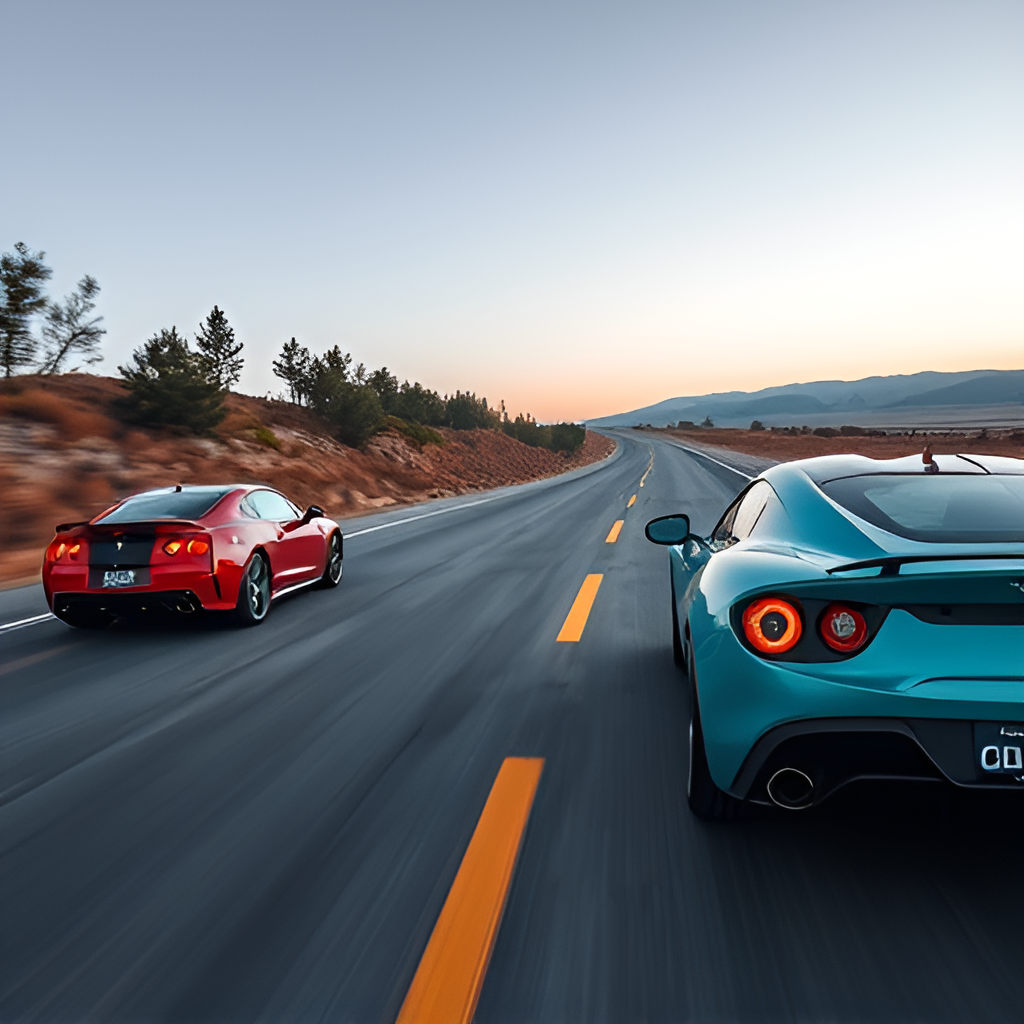
Fast and Curious: Ranking the World's Quickest Production Cars
Related Products
Share
The Need for Speed: Understanding Production Car Speed Records

There's something almost primal about our fascination with speed. When we hear the roar of a hypercar's engine or see that sleek carbon-fiber body cutting through air, most of us feel a flutter of excitement. Top speed production car records aren't just numbers on a page—they're testaments to human ingenuity and our endless pursuit of "faster."
As of 2025, the speed kings of the automotive world include some truly mind-bending machines. The Koenigsegg Jesko Absolut claims a simulated top speed of 330 mph, while the Bugatti Chiron Super Sport 300+ has a verified 304.7 mph under its belt. The SSC Tuatara has reached 295 mph in a one-way run, the Koenigsegg Agera RS holds the official two-way average record at 277.9 mph, and the Hennessey Venom GT has blasted to 270.5 mph.
Think about this: when the first production car—the 1894 Benz Velo—rolled out, it reached a modest 12 mph. That's slower than most of us jog! Fast forward to 1987, and the Ferrari F40 became the first production car to break the 200 mph barrier. Just four decades later, Bugatti smashed through 300 mph like it was just another Monday at the office.
What makes these achievements so impressive isn't just the speed itself. It's the physics they're fighting against. Every additional mile per hour requires exponentially more power to overcome aerodynamic drag. When you're pushing past 250 mph, the air resistance becomes almost solid.
Today's hypercars combine featherweight carbon-fiber construction with engines producing over 1,500 horsepower—that's like having fifteen family sedans' worth of power in one vehicle! The aerodynamics are so advanced that these cars literally manipulate the air around them, creating invisible pathways through the atmosphere.
The friendly rivalry between manufacturers has created a fascinating arms race. Bugatti, Koenigsegg, and Hennessey constantly one-up each other, pushing boundaries we once thought impossible. I love how Koenigsegg's CEO casually referred to the world speed record as a "low-hanging fruit" they're eager to pluck—as if breaking 300 mph is just a simple item on their to-do list!

Why We're Obsessed With the "Top Speed Production Car"
Our love affair with automotive speed runs deep. While Eleanor Roosevelt probably never actually said "America is all about speed, hot, nasty bad-ass speed" (despite this quote appearing everywhere), the sentiment hits home for car enthusiasts worldwide.
The exclusive "200 mph club" once had very limited membership—just a handful of exotic machines like the Ferrari F40 and McLaren F1. Now? That club's getting pretty crowded. Even some high-performance sedans are knocking on the door of speeds that were once reserved for the most exotic supercars.
But humans always need a new mountain to climb. Enter the "300 mph club"—a barrier that seemed like pure fantasy until Bugatti's Chiron Super Sport 300+ made history in 2019. It's like the four-minute mile of the automotive world—once someone proves it can be done, others follow.
This isn't just about bragging rights (though there's plenty of that). Each new milestone pushes engineering to new heights. The technology developed for these speed machines eventually trickles down to everyday cars. Those carbon-fiber components and aerodynamic tricks that help the Jesko hit unbelievable speeds? They're improving efficiency and safety in the cars we drive every day.
Whether you're tuning your BMW with performance parts from RapidVehicles.com or just dreaming about what it would feel like to hit 300+ mph, these incredible machines represent the absolute pinnacle of what happens when human ingenuity meets an obsession with going faster.
What Makes a "Production Car" Count?
When we talk about a top speed production car, we're not just referring to any fast vehicle that rolls off an assembly line. There's actually a fascinating set of rules that determine which speed demons qualify for the record books.
Think of it as the difference between a professional athlete and someone who's really good at sports. Both might be impressive, but only one can compete in the Olympics!
For a car to earn legitimate top speed production car status, it needs to clear several important problems:
First, it must be street-legal through proper homologation. This means the vehicle has passed safety and emissions tests in at least one major market like the US, European Union, or Japan. No track-only specials allowed here!
The car also needs genuine VIN series production. Those sequential vehicle identification numbers prove it's manufactured on an actual production line rather than being hand-built as a one-off special in someone's garage.
True production cars must also be available across multiple markets in the exact same specification as the record-setting version. You can't sell a neutered version to the public while keeping the really fast one for your record attempts!

Perhaps most importantly, manufacturers need to build a minimum number of identical units – traditionally 25-30 cars. This requirement has been the downfall of several would-be record holders. Remember the Hennessey Venom GT's blistering 270.49 mph run in 2014? It was never officially recognized because fewer than 30 were produced. Talk about a technicality!
Finally, official records require two-way verification runs in opposite directions. This clever rule accounts for wind assistance and road gradients that might artificially boost speeds. The average of both runs becomes the official record – no cherry-picking your fastest pass!
The Essential "Top Speed Production Car" Rules
The world of speed records can get surprisingly contentious, with millions in marketing value at stake. That's why clarity in definitions matters so much.
Minimum units requirements have evolved over time. While 25-30 identical cars was the traditional standard, Koenigsegg successfully lobbied for a power-based criterion after their Agera RS blew past previous performance thresholds. Sometimes the rules have to change when the cars get too extraordinary!
Electronic limiters have sparked heated debates. When Bugatti's Veyron Super Sport hit 267.856 mph, controversy erupted because the production version sold to customers had a speed limiter (at 258 mph) that was removed for the record attempt. Guinness initially disqualified the record but later reversed course, determining that "a change to the speed limiter does not alter the fundamental design of the car or its engine." Common sense prevailed!
The identical specification rule ensures that what sets the record matches what customers can actually buy. This prevents manufacturers from creating special one-off "ringers" just for record attempts.
Speaking of one-offs, the breathtaking Bugatti La Voiture Noire wouldn't qualify for production car records despite its €11 million price tag and monstrous 1,500 horsepower W16 engine. With only one ever made, it's more automotive artwork than production vehicle – beautiful but ineligible.
When you see claims about the "world's fastest production car," now you'll know exactly what that means – and which questions to ask before accepting the headline!
How Top Speed Is Measured and Verified
When cars are pushing past 250 mph, you can't just use a police radar gun and call it a day. Measuring the top speed production car records requires incredibly precise technology and strict protocols to ensure everything's legitimate.

Think about it – at these speeds, even tiny measurement errors could mean the difference between claiming a world record or going home disappointed. That's why manufacturers use Doppler radar systems that provide real-time speed readings as the car flies by. But the gold standard in the industry is the GPS VBOX system from Racelogic, which can measure speed with jaw-dropping accuracy – we're talking down to 0.1 km/h precision using satellite technology.
Fair is fair, though. Wind can give a massive advantage (or disadvantage), which is why official records require two runs in opposite directions on the same stretch of road. Usually, these happen within an hour of each other, and the average becomes the official speed. When Koenigsegg set their record in Nevada, this two-way average was crucial to the verification process.
Safety comes first in these extreme attempts. Before any car attempts speeds that would get you instantly jail time on public roads, tires undergo X-ray inspection to spot any hidden flaws. A tire blowout at 300+ mph would be catastrophic – there's simply no room for error when you're covering the length of a football field every second.
Speaking of roads – where do you even test a car at these speeds? Some manufacturers use private test tracks, while others, like Koenigsegg with their Agera RS run, secure special government permits to close down public highways. These permits don't come easy and often require months of planning and coordination.
Looking ahead, Koenigsegg has been preparing for something special since 2024. They've been planning a top speed run for the Jesko Absolut, aiming to verify its claimed 330 mph potential. As company founder Christian von Koenigsegg confidently stated: "We have a track that's long enough, we have the tires, and we have the car. We just need to put it all together." If you're following supercar news, this is definitely one to watch, as automotive publications have been covering the anticipated Jesko run extensively.
Science Behind Hitting the "Top Speed Production Car" Mark
Breaking speed records isn't just about raw horsepower – it's a delicate dance with physics where every detail matters.
The invisible enemy is air resistance. As speeds double, the force needed to push through air quadruples – that's why the leap from 250 to 300 mph requires exponentially more engineering than going from 200 to 250 mph. Modern hypercars combat this with incredibly slippery shapes. The SSC Tuatara, for instance, slices through air with a drag coefficient of just 0.279, while still maintaining enough downforce to keep the car planted.
Active aerodynamics play a huge role too. Gone are the days of fixed wings and splitters. Today's record-breakers use movable aero elements that adjust on the fly. The Bugatti Chiron features a hydraulic ride height system and a rear wing that tucks away into a special low-drag mode specifically for reaching its top speed. Without these clever tricks, 300+ mph would remain a fantasy.
Fuel choice makes a surprising difference at the bleeding edge. Many record attempts use E85 bioethanol rather than regular pump gas. The Koenigsegg Jesko, for example, pumps out a monstrous 1,600 hp on E85 compared to "only" 1,280 hp on regular gasoline. That extra punch can be the difference between setting a record or falling short.
Perhaps most overlooked is cooling. At these extreme velocities, managing heat becomes a nightmare. Engines, transmissions, differentials – everything gets hot when you're pushing the limits. The Bugatti Veyron famously needed ten separate radiators to keep various systems from overheating. Without solving these thermal challenges, sustained high speeds would cook components from the inside out.
All these factors work together in a complex engineering symphony. When you next see headlines about a new top speed production car record, remember it's not just about building the most powerful engine – it's about mastering the science of speed in all its intricate details.
#10 Porsche 918 Spyder — 218 MPH

The Porsche 918 Spyder might be the "slowest" entry on our list with its 218 mph top speed, but don't let that number fool you. This machine completely redefined what we expect from hybrid technology when it burst onto the scene in 2013.
Despite being a hybrid, there's nothing eco-boring about this Porsche. Its 4.6-liter naturally aspirated V8 works in perfect harmony with two electric motors to deliver a combined 875 horsepower and a massive 944 lb-ft of torque. The result? A jaw-dropping 0-60 mph time of just 2.5 seconds.
What makes the 918 truly special is its split personality. One moment, it can silently cruise for up to 12 miles on pure electric power, making you feel virtuous and eco-friendly. The next, with a press of the accelerator, it transforms into a howling track monster with its top speed production car credentials on full display.
Speaking of tracks, the 918 Spyder made history in 2013 by becoming the first production car to break the 7-minute barrier at the infamous Nürburgring Nordschleife, clocking an incredible 6:57. This wasn't just fast—it was revolutionary.
Porsche's engineers didn't stop at straight-line speed either. The 918's all-wheel drive system with rear-wheel steering delivers handling that defies physics. Limited to just 918 units (see what they did there?), this hypercar proved that hybrid technology could improve rather than compromise performance.
The 918's official 218 mph top speed was recorded in 2018, reminding us that the most innovative cars aren't always the fastest in a straight line. But they're often the most significant—paving the way for future technologies while delivering an unforgettable driving experience.
#9 Rimac Nevera — 258 MPH
The Rimac Nevera represents something truly revolutionary: an all-electric hypercar that can compete with—and often outperform—traditional combustion-engine vehicles.
Key specifications:
- Four electric motors (one per wheel)
- 1,914 horsepower and 2,300 lb-ft of torque
- 0-60 mph in a staggering 1.85 seconds (the quickest production car ever tested)
- 258 mph top speed (verified)
- 120 kWh battery pack
- Limited to 150 units
The Croatian-built Nevera achieved its verified 258 mph top speed in 2022, making it the fastest electric production car in the world. What's particularly impressive is how it overcomes the weight disadvantage inherent to battery-powered vehicles through clever engineering and carbon-fiber construction.
The instant torque from its quad-motor setup gives the Nevera acceleration capabilities that make even high-performance combustion sports cars seem tame by comparison. While traditional supercars build power as they climb through the rev range, the Nevera delivers maximum torque from a standstill.
Rimac has noted that the Nevera could potentially go even faster, but the company chose to electronically limit top speed for safety reasons. This suggests that electric hypercars may eventually challenge combustion engines even in the field of ultimate top speed.
#8 Bugatti Veyron Super Sport — 268 MPH
When the Bugatti Veyron Super Sport set its 267.856 mph record in 2010, it redefined what was possible for a production car. This record would stand for seven years, cementing the Veyron's place in automotive history.
Key specifications:
- 8.0-liter quad-turbocharged W16 engine
- 1,200 horsepower and 1,106 lb-ft of torque
- 0-60 mph in 2.4 seconds
- Carbon fiber monocoque chassis
- Special Michelin PAX run-flat tires costing $25,000 per set
- Production limited to 30 units
The Veyron Super Sport's record came with controversy. Guinness World Records temporarily rescinded the title when it was revealed that customer cars had their top speeds electronically limited to 258 mph, while the record car had this limiter removed. After review, Guinness reinstated the record, determining that the limiter didn't alter the fundamental design of the car.
Jeremy Clarkson famously called the Veyron "the greatest car ever made and the greatest car we will ever see in our lifetime," while James May described it as "our Concorde moment." The car's engineering was so extreme that its engine consumed 45,000 liters of air per minute at full speed—equivalent to what a human breathes in four days.
The Veyron Super Sport's high-speed cooling systems were particularly impressive, with ten separate radiators managing temperatures for the engine, intercoolers, transmission, differential, and air conditioning.
#7 Hennessey Venom GT — 270 MPH
The Texas-built Hennessey Venom GT achieved a one-way verified top speed of 270.49 mph in 2014, though it never received official recognition as the world's fastest production car due to limited production numbers and the lack of a two-way average.
Key specifications:
- 7.0-liter twin-turbocharged V8 engine
- 1,244 horsepower and 1,155 lb-ft of torque
- 0-60 mph in 2.7 seconds
- Modified Lotus Exige chassis
- Weight of just 2,743 pounds
- Only 13 units produced
What began as John Hennessey "joking about placing a twin-turbo engine in a Lotus Exige" evolved into one of the fastest cars ever built. The Venom GT's power-to-weight ratio was its secret weapon—a car weighing less than 3,000 pounds with over 1,200 horsepower is a recipe for extreme performance.
The record run took place on the 3.2-mile Space Shuttle landing runway at NASA's Kennedy Space Center in Florida. Test driver Brian Smith noted afterward: "The car was still accelerating when we ran out of room. With a longer track, the Venom GT could go faster."
Despite its impressive achievement, the Venom GT's limited production run (well below the 30-unit threshold) and one-directional run prevented it from claiming official records. Nevertheless, it demonstrated that American engineering could compete with the European hypercar establishment.
#6 SSC Tuatara — 295 MPH
The path to 295 mph wasn't exactly smooth sailing for the SSC Tuatara. This American hypercar's speed journey reads like a drama-filled Netflix series. After initially claiming a jaw-dropping 331 mph run that sent the automotive world into a frenzy, the celebration came to a screeching halt when internet sleuths and video analysts uncovered GPS data inconsistencies that couldn't be ignored.
Rather than give up, SSC regrouped and did what respectable manufacturers do – they tried again with proper verification in place.
Key specifications:
- 5.9-liter twin-turbocharged flat-plane crank V8
- 1,350 horsepower on regular 91 octane fuel (jumps to a monstrous 1,750 hp on E85 biofuel)
- Featherlight carbon fiber monocoque chassis
- 0-60 mph in a blink-and-you'll-miss-it 2.5 seconds
- Slippery drag coefficient of just 0.279
- Limited production run of 100 units
In January 2022, redemption came at the Johnny Bohmer Proving Grounds at Kennedy Space Center. With proper verification equipment and witnesses, the Tuatara achieved a certified average speed of 282.9 mph over two runs, with its peak one-way speed hitting 295 mph. This officially places it as the third-fastest production car in the world by verified top speed production car standards.
What makes the Tuatara truly special is its obsessive focus on aerodynamic efficiency. Designer Jason Castriota (who cut his teeth at Ferrari and Maserati) crafted a body that slices through air with minimal resistance while somehow maintaining rock-solid stability when approaching 300 mph – a delicate balancing act that many hypercars attempt but few master.
"At those speeds, air behaves more like a solid than a gas," explained one SSC engineer. "The Tuatara had to be designed to part that air without creating lift that would send the car airborne."
SSC founder Jerod Shelby (who, despite the last name, has no relation to Carroll Shelby) hasn't given up on the 300+ mph dream. He's been clear that the company still aims to break the magical 300 mph barrier with the Tuatara, suggesting we haven't yet seen what this American-made monster is fully capable of achieving.
The Tuatara's story reminds us that the top speed production car world is as much about integrity in verification as it is about raw engineering prowess – a lesson learned the hard way, but one that makes its verified achievements all the more impressive.
#5 Bugatti Chiron Super Sport 300+ — 304 MPH

When it comes to shattering barriers in the automotive world, few moments compare to August 2, 2019. That's when the Bugatti Chiron Super Sport 300+ did what many thought impossible – it smashed through the mythical 300 mph wall, recording a mind-bending 304.77 mph at Volkswagen's Ehra-Lessien test track in Germany.
This wasn't just another speed record. This was the automotive equivalent of breaking the sound barrier.
Behind the wheel sat legendary test driver Andy Wallace – the same man who set the McLaren F1's original speed record back in 1998. Talk about coming full circle! Wallace later described the sensation at such speeds: "It's not just the brute force of acceleration. At 300+ mph, you're covering a football field every second. The world becomes a blur."
What makes this beast tick? The heart of the top speed production car is Bugatti's masterpiece: an 8.0-liter quad-turbocharged W16 engine pumping out 1,578 horsepower. That's roughly equivalent to 15 family sedans combined into one carbon fiber missile.
Bugatti didn't just crank up the power, though. The Super Sport 300+ features a specially designed "longtail" body that extends the car by about 10 inches compared to the standard Chiron. This seemingly small change dramatically improves aerodynamics when you're pushing against air resistance at such extreme velocities.
Perhaps most impressive was the tire technology. Michelin created special Pilot Sport Cup 2 tires that could withstand the incredible forces at play – each tire experiences around 5,300 G while rotating at 300+ mph. Before the run, technicians X-rayed every tire to ensure there were no hidden flaws that could lead to catastrophic failure.
Unlike some other record attempts, Bugatti completed only a one-way run rather than the typical two-way average. The company explained that Ehra-Lessien's safety features are optimized for running in a single direction, making a return run potentially dangerous. Still, the achievement stands as a watershed moment in automotive history.
For the lucky 30 customers who snagged one for $3.9 million each, their production versions come electronically limited to "just" 273.4 mph – still faster than almost anything else on the road. Each car wears the same striking black and orange color scheme as the record-setting vehicle, a not-so-subtle reminder that you're driving a piece of history.
As Bugatti's then-president Stephan Winkelmann noted after the record: "We have shown several times that we build the fastest cars in the world. In future we will focus on other areas." With that statement, Bugatti effectively planted its flag at the 490 km/h mark and walked away from the top speed wars – at least for now.
#4 Hennessey Venom F5 — 311 MPH (Claimed)
When it comes to American muscle in the hypercar world, the Hennessey Venom F5 stands tall with Texas-sized ambition. With a claimed top speed of 311 mph, this beast represents America's boldest entry in the top speed production car race.
Think of the Venom F5 as the embodiment of the American dream on wheels—audacious, powerful, and unapologetically fast. Named after the most powerful category of tornado on the Fujita scale, this hypercar aims to create a similar whirlwind in the automotive world.
Key specifications:
- 6.6-liter twin-turbocharged "Fury" V8 engine
- 1,817 horsepower and 1,193 lb-ft of torque
- 0-60 mph in 2.6 seconds
- Carbon-fiber monocoque chassis
- Weight of just 2,998 pounds
- Limited to 24 units at $1.8 million each
The heart of this speed demon is its appropriately named "Fury" V8 engine. Hand-built in Texas, this powerplant produces more horsepower than many small aircraft while weighing less than some compact cars. It's American engineering at its finest—brash, powerful, and effective.
John Hennessey, the company's founder, keeps his approach refreshingly straightforward: "We could build this car with 1,000+ hp and a weight well under 3,000 lbs," he's stated, highlighting the company's focus on power-to-weight ratio rather than just headline-grabbing horsepower numbers.
The Venom F5 has already proven its potential during testing, reaching 271.6 mph—and that's just a taste of what's possible. Hennessey plans to conduct the official top-speed verification on a closed public highway in the United States, following Koenigsegg's playbook with the Agera RS.
What makes the Venom F5 particularly interesting is its relatively uncomplicated approach. While European rivals employ complex hybrid systems or elaborate aerodynamics, Hennessey sticks to a proven formula: lightweight chassis, enormous power, and slippery aerodynamics. Sometimes the simplest solutions yield the most impressive results.
The 24 lucky owners of this American hypercar aren't just buying a vehicle—they're buying a potential piece of automotive history. If the Venom F5 achieves its claimed top speed under verified conditions, it would cement Hennessey's place among the hypercar elite and prove that American engineering can compete with the best from Europe.
#3 Bugatti Bolide — 311 MPH (Claimed)
While most hypercars balance luxury with performance, the Bugatti Bolide takes a radically different approach. This track-focused beast strips away comfort and opulence in the relentless pursuit of raw speed.
Key specifications:
- 8.0-liter quad-turbocharged W16 engine
- 1,825 horsepower and 1,364 lb-ft of torque
- 0-60 mph in 2.17 seconds
- Extreme lightweight construction (2,734 pounds)
- X-shaped taillights inspired by fighter jets
- Limited to 40 units at approximately $4.7 million each
The Bolide's journey from concept to reality speaks volumes about its appeal. Initially unveiled as a one-off design study, Bugatti quickly announced a limited production run after being flooded with customer interest. With its claimed top speed of 311 mph still theoretical, the automotive world waits with bated breath for verification. But the numbers tell a compelling story – its power-to-weight ratio of 0.67 hp per pound provides a solid foundation for record-breaking potential.
What truly sets the Bolide apart is its unapologetic minimalism. Unlike its luxury-oriented sibling, the Chiron, this top speed production car contender accepts a "less is more" philosophy. Every component serves a singular purpose: speed. As Bugatti President Stephan Winkelmann eloquently put it, the Bolide represents "the most extreme, uncompromising, fastest and lightest vehicle concept in the company's recent history."
The Bolide's striking design features fighter jet-inspired elements, including X-shaped taillights that give it an unmistakable presence. Its aggressive aerodynamics aren't just for show – they're engineered to keep the car planted at speeds that would send lesser vehicles airborne.
Bugatti has teased that "a new chapter of best performance is on the horizon," hinting that the Bolide might eventually attempt to reclaim the top speed crown for the storied French brand. For enthusiasts who find the Affordable McLaren options too tame, the Bolide represents the ultimate expression of automotive excess – a track-focused hypercar that makes no compromises in its quest for speed supremacy.
#2 Koenigsegg Agera RS — 278 MPH (Official Two-Way)

When it comes to officially verified speed records, the Koenigsegg Agera RS stands tall with its impressive 277.87 mph two-way average. What makes this achievement so remarkable? It happened on a regular (albeit closed) stretch of Nevada highway in November 2017 – not on a purpose-built test track.
This wasn't even a factory prototype. The Swedish manufacturer used a customer's actual car for the attempt! Factory driver Niklas Lilja pushed the Agera RS to a blistering 284.55 mph in one direction before turning around and hitting 271.19 mph going the opposite way. The average of these runs gave us the official top speed production car record that stood until Bugatti's Chiron came along.
"We knew the car had more to give," Lilja mentioned after climbing out of the cockpit. "But we also wanted to prove it's quicker than anything else in the corners too." And prove it they did – the same car set a record for the 0-249-0 mph sprint (that's 0-400-0 km/h for our metric friends), completing this brutal acceleration-and-braking test in just 36.44 seconds.
Under the hood, the Agera RS packs a 5.0-liter twin-turbocharged V8 producing 1,160 horsepower on regular pump gas. Switch to E85 biofuel, and that figure jumps to an eye-watering 1,341 hp – earning it the "megacar" nickname as the first production vehicle to exceed one megawatt of power.
This power-to-weight achievement actually changed the record books themselves. Koenigsegg successfully convinced record-keeping organizations to replace the traditional 25-car minimum production rule with a power-based eligibility criterion. With its carbon fiber and aluminum honeycomb chassis, active aerodynamics, and only 25 examples built, the Agera RS represents the pinnacle of boutique hypercar engineering.
The Nevada highway run wasn't just about bragging rights – it showed that Swedish engineering could outpace the established hypercar royalty from more traditional supercar-producing nations. Not bad for a company founded in 1994 by a young entrepreneur with a dream of building the perfect sports car.
#1 Koenigsegg Jesko Absolut — 330 MPH (Simulated)
At the top of our list sits the Koenigsegg Jesko Absolut with its claimed potential top speed of 330 mph—a figure that, if verified, would shatter all existing records and potentially remain unbeaten for years to come.
Key specifications:
- 5.0-liter twin-turbocharged V8 engine
- 1,280 hp on regular gasoline (1,600 hp on E85)
- 9-speed "Light Speed Transmission" with multiple simultaneous gear changes
- Active rear wing for stability
- Drag coefficient of just 0.278
- Limited production run
The Jesko Absolut represents Koenigsegg's dedicated attempt to build the ultimate top speed production car. Company founder Christian von Koenigsegg has stated: "The Jesko Absolut is a land-based rocket ship determined to reach unheard-of speed in record-setting pace."
What makes the Jesko Absolut special is its focus on aerodynamic efficiency. Compared to the standard Jesko, the Absolut removes the massive rear wing in favor of two fins inspired by the F-15 fighter jet, reducing drag significantly while maintaining stability.
Koenigsegg has been working toward a verified top speed run since 2024, potentially cementing the Jesko Absolut's place in automotive history. The company has indicated this will be their final attempt at a top speed record, making it all the more significant.
The Jesko's "Light Speed Transmission" is particularly innovative, allowing multiple simultaneous gear changes to find the optimal ratio instantly—critical when pushing beyond 300 mph where conventional transmissions might struggle.
Frequently Asked Questions About Top Speed Records
How are "top speed production car" runs policed for fairness?
When millions of dollars and prestigious bragging rights are on the line, you can bet that top speed production car record attempts are scrutinized with incredible detail.
Think of these record runs like Olympic events—they need referees. Independent organizations like Guinness World Records typically oversee the process, bringing professional equipment including Racelogic VBOX GPS systems that track speed with satellite precision. These aren't your smartphone GPS apps—they're accurate to within fractions of a mph.
The gold standard for verification is the two-way average. Since wind and slight road gradients can easily add or subtract several mph at these extreme speeds, legitimate records require runs in both directions on the same stretch of road, usually within an hour of each other.
"We had perfect conditions that day in Nevada," recalled a Koenigsegg engineer about their Agera RS record run. "But we still did both directions to remove any doubts about wind assistance."
The verification team also ensures the car is truly production-spec—no special engines, no one-off modifications, nothing customers couldn't buy themselves. This rule has tripped up several manufacturers whose "production" claims later proved questionable.
The importance of proper verification became painfully obvious in 2020 when SSC had to withdraw its initial 331 mph Tuatara claim after internet sleuths spotted inconsistencies in the video footage. The company later achieved a still-impressive but lower verified speed, showing just how critical proper documentation is to maintain credibility.
Do electric hypercars face unique top-speed limits?
Electric hypercars like the Rimac Nevera are engineering marvels, but they face their own set of challenges when hunting for speed records.
Battery heat management becomes the nemesis of sustained high-speed runs. While a combustion engine might run hot at top speed, batteries generating 1,900+ horsepower create enormous heat that must be dissipated. The Nevera's cooling system is as impressive as its motors—without it, performance would rapidly deteriorate as protective systems kick in to prevent damage.
Electric motors also have their own speed limitations. Unlike combustion engines that can rev higher with strengthened internals, electric motors have absolute RPM limits based on their physical design. This creates a ceiling that requires clever gearing solutions to overcome.
"The weight is always the biggest challenge," noted a Rimac engineer. Electric hypercars carry hundreds of pounds of batteries that combustion cars don't need, creating a physics disadvantage that requires more power to overcome.
Yet despite these problems, the Rimac Nevera's verified 258 mph proves electric hypercars can compete at the highest levels. As battery technology improves—becoming lighter and more energy-dense—we may soon see an electric vehicle claim the absolute top speed crown.
Why do claimed speeds differ from verified numbers?
The gap between what manufacturers claim and what they can verify often comes down to the difference between theory and reality.
Computer simulations can calculate a theoretical top speed based on power, drag, and gearing—all assuming perfect conditions. But the real world rarely cooperates. Finding a track long enough for these speed monsters is challenging; many test facilities simply don't have enough runway for cars to reach their potential.
Weather plays a surprising role too. Air density, temperature, and even humidity affect engine performance and aerodynamics. A hot, humid day might cost several mph compared to cool, dry conditions.
Then there's the matter of safety. Bugatti limits customer Chirons to "just" 261 mph despite proving the platform can exceed 300 mph. Why? Because even the special Michelin tires developed for these speeds have their limits, especially when they need to last more than just a record attempt.
"We could go faster," admitted one hypercar manufacturer, "but we'd need to close a highway, get special permits, and use tires that might only last for that one run. That's not what our customers can realistically do."
This explains why the Koenigsegg Jesko Absolut's claimed 330 mph remains theoretical until proven. The company has the calculations to support it but still needs the perfect combination of car, driver, location, and conditions to make history.
At the end of the day, these incredible machines represent the absolute pinnacle of what's possible when engineering meets ambition—whether their top speeds are claimed or verified.
Conclusion
The pursuit of the top speed production car record represents one of humanity's most thrilling engineering challenges. What began with the modest 12 mph Benz Velo in 1894 has evolved into today's 300+ mph hypercars—a journey that showcases our relentless desire to push boundaries.
Looking toward the horizon in 2025, the landscape of automotive speed is changing dramatically. Electric hypercars like the Rimac Nevera aren't just participating in the conversation—they're reshaping it entirely. With instant torque delivery and rapidly advancing battery technology, we may soon see electric vehicles challenging combustion engines for the absolute speed crown.
The aerodynamic battle becomes increasingly crucial as speeds climb. Engineers now spend thousands of hours in wind tunnels and computer simulations to find those precious tenths of a drag coefficient point. The difference between 299 mph and 300+ mph often comes down to the smallest aerodynamic details—a testament to how we're pushing against the very limits of physics.
Safety engineering has evolved in parallel with these speed achievements. When a tire blowout at 200 mph was once catastrophic, today's hypercars incorporate sophisticated systems to maintain stability even when things go wrong at over 300 mph. The carbon-fiber tubs, crash structures, and advanced safety systems represent innovation that protects drivers pushing these extraordinary limits.
There's also a bittersweet reality to this pursuit. As global emissions regulations tighten, the days of massive displacement engines with minimal restrictions may be numbered. The Bugatti W16 and other engineering marvels might represent the spectacular finale of an era rather than a stepping stone to what comes next.
At RapidVehicles.com, we celebrate these engineering masterpieces not just for their headline-grabbing numbers, but for what they represent—human ingenuity at its finest. While most of us will never experience 300+ mph (and truthfully, few of the owners of these hypercars will either), these vehicles inspire innovation throughout the automotive world. The carbon-fiber construction, aerodynamic solutions, and hybrid powertrains pioneered in these speed machines eventually influence the cars we all drive.
The competition for the top speed production car title may seem academic in a world of speed limits and traffic congestion, but it represents something profoundly human—our desire to see just how far we can go. Whether Koenigsegg, Bugatti, Hennessey or some newcomer claims the next record, we'll all share in the excitement of witnessing automotive history being made.
For more information about the latest supercar news and developments, visit our supercar news section where we regularly update our readers on the fastest and most exciting vehicles in the world.






